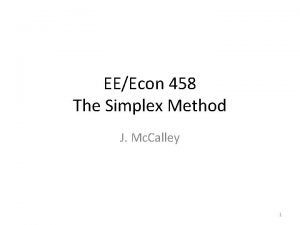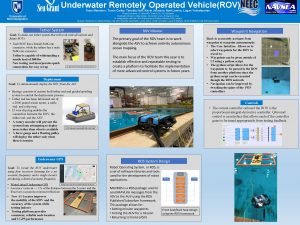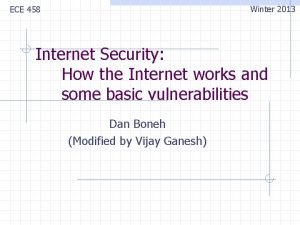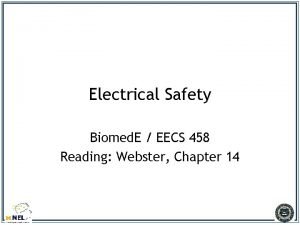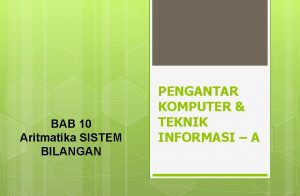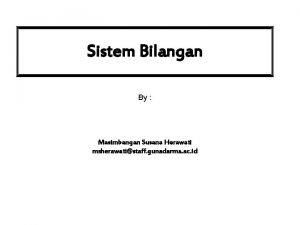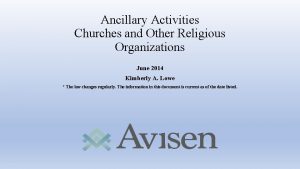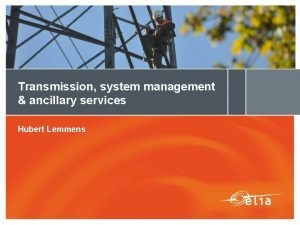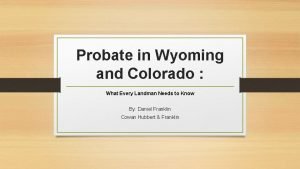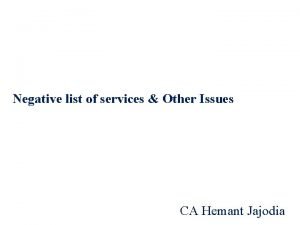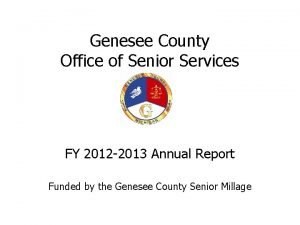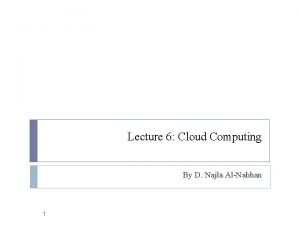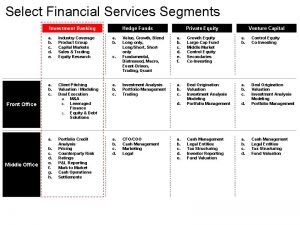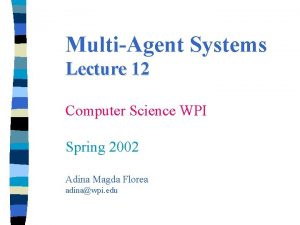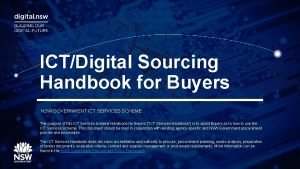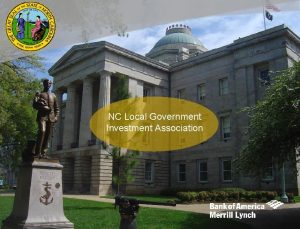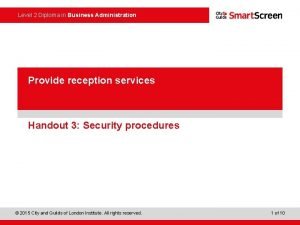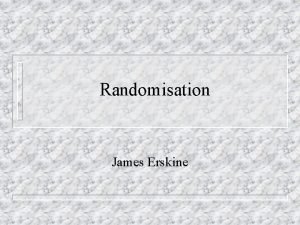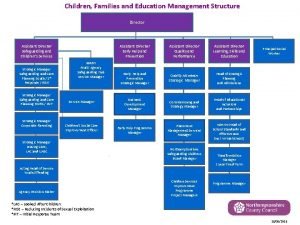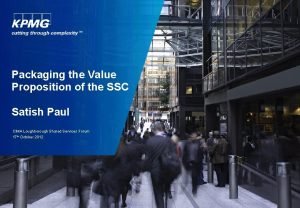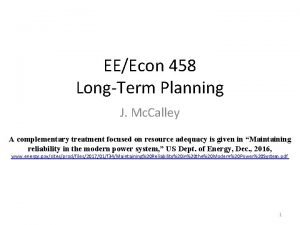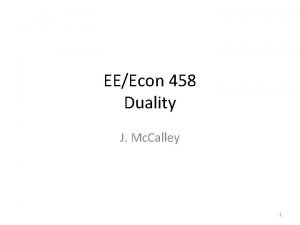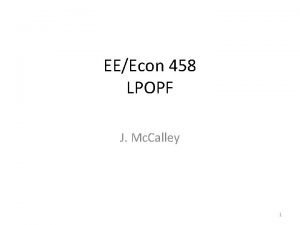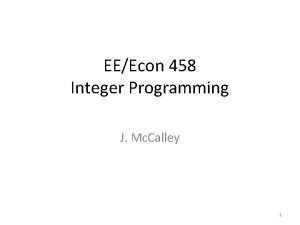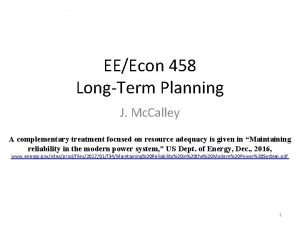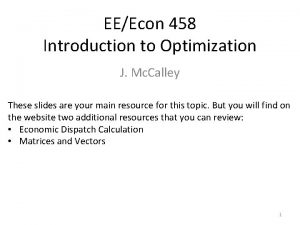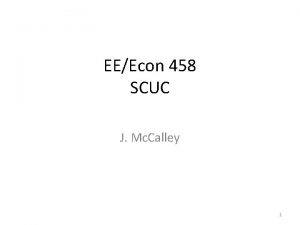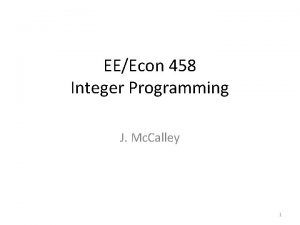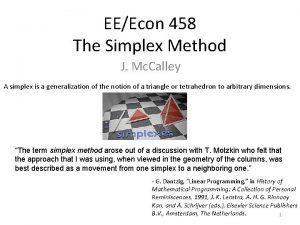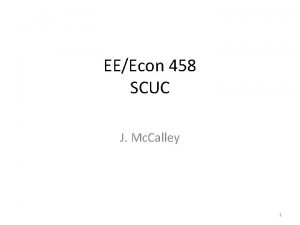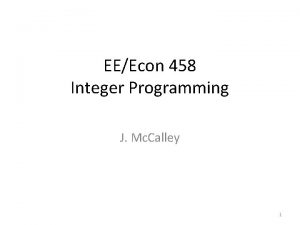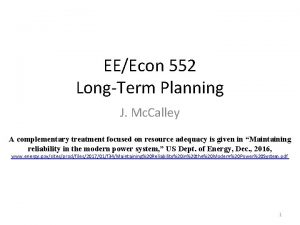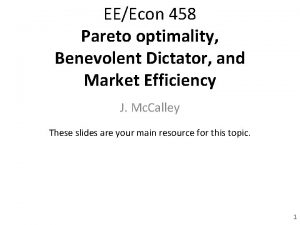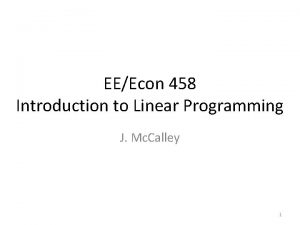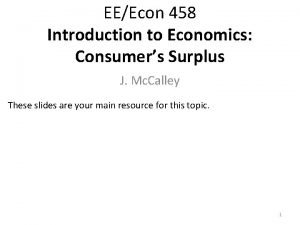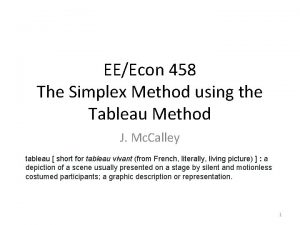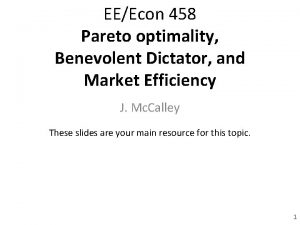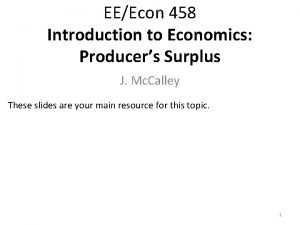EEEcon 458 Ancillary Services J Mc Calley 1






























































- Slides: 62

EE/Econ 458 Ancillary Services J. Mc. Calley 1

Ancillary Services – Old Definition Ancillary services are defined as services necessary to support capacity and the transmission of energy from resources to loads while maintaining reliable operation of the transmission system in accordance with good utility practice, according to FERC Order 888 [1], which requires RTS to provide the following ancillary services: 1. 2. 3. 4. 5. 6. Scheduling, system control and dispatch service Reactive supply and voltage control service Regulation and frequency response services Energy imbalance service Operating reserves – spinning reserve service Operating reserves - supplemental reserve service [1] www. ferc. gov/legal/maj-ord-reg/land-docs/rm 95 -8 -00 w. txt, 1996. 2

Ancillary Services – Alternative Definition Ancillary services are an important piece of grid operations: they represent essential reliability services, albeit “ancillary” to the much larger and fundamental provision of energy and capacity from generators. Typically, ancillary services are defined as those functions that help grid operators maintain the reliability of the electricity system over very short periods of time up to one day. Ancillary services provide the flexibility needed to respond to variations in supply and demand, as well as maintaining frequency and voltage [2] “Electricity ancillary services primer, ” Reishus Consulting LLC, August, 2017, http: //nescoe. com/wp-content/uploads/2017/11/Anx. Svc. Primer_Sep 2017. pdf 3

Balancing Systems min ENERGY & ΣΣ zit{Cost(GENit)+Cost(RSRVit)} Reg/Cont sbjct to ntwrk+status cnstraints SELL OFFERS LARGE MIXED INTEGER PROGRAM BOTH CO-OPTIMIZE: energy & reserves min ΣΣ {Cost(GENit)+Cost(RSRVit)} sbjct to ntwrk cnstraints LARGE LINEAR PROGRAM NETWORK ENERGY & Reg/Cont SELL OFFERS DAY-AHEAD ENERGY BUY BIDS MARKET 1 sol/day gives 24 oprting cdtns Reg&Cont rsrve rqrmts REAL-TIME MARKET ENERGY BUY BIDS 1 sol/5 min gives 1 oprtng cdtn Reg&Cont rsrve rqrmts AUTOMATIC GENERATION CONTROL SYSTEM ACE=f(ΔTIE FLOWS, ΔFREQUENCY) 4

Summary of types of reserves 5

REGULATION VS LOAD FOLLOWING = + Load Following Regulation Steve Enyeart, “Large Wind Integration Challenges for Operations / System Reliability, ” presentation by Bonneville Power Administration, Feb 12, 2008, available at http: //cialab. ee. washington. edu/nwess/2008/presentations/stephen. ppt. 6

Regulation vs. Contingency Reserves • “Regulating”: To handle the moment-to-moment variation in load (or net load where variable generation has significant presence). Pulses every 4 seconds but ~5 min response time. • “Contingency”: To compensate for unexpected imbalances usually caused by a gen trip. Contingency reserves must be available within 10 mins following a request. There are 2 types of contingency reserves: Ø Spinning reserve: reserve from units that are connected Ø Supplementary reserve: reserve from units not connected 7

Regulation vs. Contingency Reserves 8

Summary of ISO ancillary services Z. Zhou, T. Levin, G. Conzelmann, “Survey of US Ancillary Services Markets, ” Argonne National Laboratory, ANL/ESD-16/1, January, 2016, https: //publications. anl. gov/anlpubs/2016/01/124217. pdf 9

AREA CONTROL ERROR (ACE) The formula for calculating raw ACE is as Neglect IME follows: ACE= (Pexp, A –Pexp, S) – 10 B (FA - 60) ACE= (ΔPexp) – 10 B (ΔF ) So ACE is a signal to tell the generators how much to change in order to correct exports and frequency to their scheduled values. Pexp=P 1+P 2+P 3 REST OF THE INTERCONNECTION P 1 BA P 3 P 2 ACE = (NAI – NSI) – 10 B (FA – FS) – IME NAI, Pexp, A: Net Actual Interchange – sum of actual flows on all Tie Lines: actual export NSI, Pexp, S: Net Scheduled Interchange – sum of scheduled flows on all tie lines: scheduled export FA, FA: Actual Frequency FS, 60: Scheduled Frequency B: Frequency Bias setting (MW/0. 1 Hz) for MISO. The constant factor of 10 converts the frequency setting to MW/HZ. B is a negative number. 10 IME: meter error correction

AREA CONTROL ERROR (ACE) ACE= (ΔPexp) – 10 B (ΔF) So ACE is a signal to tell the generators how much to change in order to correct exports and frequency to their scheduled values. If ACE>0, units are pulsed to lower gen. If ACE<0, units are pulsed to raised gen Should be 50 MW/0. 1 Hz “Balancing and Frequency Control: A Technical Document, ” prepared by the NERC Resources Subcommittee, Jan 26, 2011, www. nerc. com/docs/oc/rs/NERC%20 Balancing%20 and%20 Frequency%20 Control%20040520111. pdf. Reference: E. Ela, M. Milligan and B. Kirby, “Operating reserves and variable generation, ” NREL Technical Report TP-5500 -51978, Aug. , 2011, at http: //www. nrel. gov/docs/fy 11 osti/51978. pdf. 11

AREA CONTROL ERROR (ACE) ACE= (ΔPexp) – 10 B (ΔF) So ACE is a signal to tell the generators how much to change in order to correct exports and frequency to their scheduled values. If ACE>0, units are pulsed to lower gen. If ACE<0, units are pulsed to raised gen If ΔPexp=0, ΔF=0, then ACE=0, and generation does not change; If ΔPexp>0 which means the actual export exceeds the scheduled export, then this component would make ACE more positive therefore tending to reduce generation; If ΔF>0 which means the actual frequency exceeds the scheduled frequency of 60 Hz, then this component would make ACE more positive therefore tending to reduce generation (remember, B<0). 12

AREA CONTROL ERROR (ACE) ACE= (ΔPexp) – 10 B (ΔF ) So ACE is a signal to tell the generators how much to change in order to correct exports and frequency to their scheduled values. If ACE>0, units are pulsed to lower gen. If ACE<0, units are pulsed to raised gen Reg>0 ACE<0 13

How Does Power System Handle Variability Turbine-Gen N Turbine-Gen … Turbine-Gen 2 Turbine-Gen 1 ACE= ∆Pexp 10 B∆F ∆Ptie Secondary control provides regulation Primary controls output in response to transient frequency deviations but deadband prevents response under normal) ∆f 14

What causes Large ACE excursions? ACE= (ΔPexp) – 10 B (Δf ) 1. Actual exports ≠ Scheduled exports: Pexp, A ≠ Pexp, S 2. Actual frequency ≠ Scheduled frequency: FA ≠ 60 What causes #1? My BA produces too much or too little MW due to • Variations in demand • Imperfect control over gens (not enough gens, gens too slow, metering/communication/forecasting error) What causes #2? Interconnection produces too much or too little MW due to • Variations in demand • Imperfect control over gens (not enough gens, gens too 15 slow, metering/communication/forecasting error)

Two types of demand variations 1. “Small” due to “normal” variation (occurring continuously); response is via AGC and not governors (due to gov deadband). 2. “Large” due to contingencies (rare). Response is via governors and then AGC. Eastern Interconnection Frequency – 2/1/11; (1 -min values) This is at very course time resolution (1 -min intervals). “Analysis of power system impacts and frequency response performance: February 1 -4, 2011 Texas & Southwestern 16 U. S. Cold Snap, ” September, 2011.

Frequency Response to a Contingency • The frequency declines from t=0 to about t=2 seconds. This frequency decline is due to the fact that the loss of generation has caused a generation deficit, and so generators decelerate, utilizing some of their inertial energy to compensate for the generation deficit. • The frequency recovers during the time period from about t=2 seconds to about t=9 seconds. This recovery is primarily due to the effect of governor control (underfrequency load shedding also plays a role). • At the end of the simulation period, the frequency has reached a steady-state, but it is not back to 60 Hz. This steadystate frequency deviation is intentional on the part of the governor control and ensures that different governors do not constantly make adjustments against each other. The resulting steady-state error will be zeroed by the actions of the automatic generation control (AGC). This is a severe MW loss contingency in the western US. 17

Frequency Response to a Contingency 18

Summary of power balance control levels No. Control Name Time frame Control objectives Function 0 -5 secs Power balance and transient frequency dip minimization Transient frequency control 1 Inertial response 2 Primary control, governor 1 -20 secs Power balance and transient frequency recovery 3 Secondary control, AGC 4 secs to 3 mins Power balance and steadystate frequency Regulation Power balance and economic-dispatch Load following and reserve provision 4 5 Real-time market Every 5 mins Day-ahead market Every day Power balance and Unit commitment and economic-unit commitment reserve provision 19

Frequency Response to a Contingency Transient control (primary) 1 2 Real-time dispatch AGC (secondary)(load following) 3 4 Numbers 1 -4 correspond to numbers on table in previous slide. We are here concerned with #2 (for contingencies) and #3 (for steady-state & contingencies). The Sequential Actions of frequency control following the sudden loss of generation and their impact on system frequency 20

ACE Excursions: Why care? 3 reasons 1. Because ACE excursions reflect frequency variation… • F<59. 0 Hz can impact turbine blade life. • Gens may trip on UF relay (59. 94 Hz, 3 min; 58. 4, 30 sec; 57. 8, 7. 5 sec; 57. 3, 45 cycles; 57 Hz, instantaneous) • UFLS can trip interruptible load (59. 75 Hz) and 5 blocks (59. 1, 58. 9, 58. 7, 58. 4, 58. 3 Hz) • Can violate performance criteria: Performance criteria is a “protection” against UFLS is a “protection” against generator tripping. Generator tripping is a “protection” against loss of turbine life. 21 21

ACE Excursions: Why care? 3 reasons 2. Because ACE excursions reflect export deviation… Inadvertent flows will increase, possibly contributing to congestion on circuits. 3. Because ACE excursions require generators to move… Generator control action costs money due to additional maintenance required in the long-term. Regulation mileage: Sum of the absolute change in output between four-second set points 22

Small vs. Large LARGE SMALL J. Dagle, “Power grid impacts resulting from unintentional demand response, ” TCIPG Seminar Series on Technologies for a Resilient Power Grid, ” Feb 3, 2012. 23

Small vs. Large Don’t miss the difference between control action for small MW deviations and control action for large MW deviations. Conditions SMALL MW DEVIATIONS LARGE MW DEVIATIONS Normal Not normal How frequently ? Continuously Rarely Cause Fluctuations in load and/or wind/solar Contingency (loss of a generation unit) ACE deviation Small Large Control action AGC Governor & AGC Reserves used Regulation only Contingency and regulation Both cost money; gens providing it need to be paid for their (ancillary) services. 24 www. nerc. com/pa/RAPA/PA/Pages/Frequency. Excursions. aspx

25

How do amount of reserves and their response speed affect ACE? • Magnitude of ACE excursions to normal MW changes decrease in magnitude when regulating reserves are increased or made faster. • Duration of ACE excursions to contingencyrelated MW changes decrease when contingency reserves are increased or made faster and when regulating reserves are increased or made faster. The industry has developed a way to measure the control performance. . . 26

Control performance standards Control Performance Standards CPS 1 and CPS 2 evolved from earlier metrics and were enacted by NERC in 1997 to evaluate a balancing area’s frequency control performance in normal interconnected power system operations. The motivation underlying CPS is to ensure a targeted long term frequency control performance of the entire interconnection. CPS measures each balancing area’s frequency control performance in achieving control objectives. N. Jaleeli and , L. Van. Slyck, “Control performance standards and procedures for interconnected operation, ” Electric Power Research Institute, Dublin, Ohio, Tech. Rep. TR-107813, Apr. 1997. N. Jaleeli and L. S. Vanslyk, “NERC’s new control performance standards. IEEE Trans. Power Syst. , ” vol. 14, pp. 1092 -1099, Aug. 1999. 27

Control performance standards CPS 1 CPS 2 NERC Standard BAL-001 -0. 1 a — “Real power balancing control performance, ” http: //www. nerc. com/files/BAL-001 -0_1 a. pdf. 28

CPS 1: a measure of a balancing area’s long term (12 mo) frequency performance. • Control objective - bound excursions of 1 -minute average frequency error over 12 months in the interconnection. • Measures control performance by comparing how well a balancing area’s ACE performs in conjunction with the frequency error of the interconnection. Average ACE, ΔF over 1 min to compute: 10 B to give units of Hz. Drop “ 1 min” subscripts; substitute ACE equation into CP equation to obtain: The compliance factor is given by ε 1 =target bound for 12 month of 1 min avg freq error. e. g. , 0. 018 Hz in EI, 0. 0228 Hz in WECC, 0. 030 Hz in ERCOT, 0. 021 in Quebec. Must be squared to normalize Hz 2 in numerator. Standard BAL‐ 001‐ 2 – Real Power Balancing Control Performance, www. nerc. com/pa/Stand/Reliability%20 Standards/BAL-001 - 29

CPS 1: a measure of a balancing area’s long term (12 mo) frequency performance. (*) The control performance metric is given by We desire -∞<CF<1 to satisfy above. Observe in (*) term 2 is always positive. We get less positive CF if term 1<0. Since the term 1 denominator is positive (B<0), term 1<0 when ΔPtieΔF<0 which happens when ΔPtie and ΔF are opposite signs. Given that we observe the “helping” mode (BA helps interconnection) is: • Fa<60 and Ptie, a>Ptie, s which means under-frequency and over-generating • Fa>60 and Ptie, a<Ptie, s which means over-frequency and under-generating. and the “hurting” mode (BA hurts interconnection) is: • Fa<60 and Ptie, a<Ptie, s which means under-frequency and under-generating • Fa>60 and Ptie, a>Ptie, s which means over-frequency and over-generating. Ref: www. burnsmcd. com/Bench. Mark/Article/Balancing-the-Grid 30

CPS 1: a measure of a balancing area’s long term (12 mo) frequency performance. Problem: balancing area can grossly over- or under-generate (as long as it is opposite frequency error) and get very good CPS 1, yet impact its neighbors with excessive flows. For example, if Fa<60, then a BA could make Ptie, a>> Ptie, s. to force CF to be very negative, making CPS 1 very high. And so CPS 2 was developed to address this. CPS 2 was then replaced by a different measure called Balancing Authority ACE Limit (BAAL); it sets a limit on ACE for each BA. 31

How much regulating reserves to have? BAAL Reference: E. Ela, M. Milligan and B. Kirby, “Operating reserves and variable generation, ” NREL Technical Report TP-5500 -51978, Aug. , 2011, at http: //www. nrel. gov/docs/fy 11 osti/51978. pdf. 32

How much contingency reserves to have? WHEN ACE>0 WHEN ACE<0 Reference: E. Ela, M. Milligan and B. Kirby, “Operating reserves and variable generation, ” NREL Technical Report TP-5500 -51978, Aug. , 2011, at http: //www. nrel. gov/docs/fy 11 osti/5197 33 8. pdf.

Conceptual evolution of AS Markets 1. Previous to electricity markets, AS costs were buried in the cost of a vertically-integrated company’s rates charged to consumers. 2. When electric energy markets were formed, it became clear a. AS provision was a service, distinct from energy b. Those providing AS were spending money that was not compensated 3. How to pay for it? Three approaches were tried a. Outside of a market b. Sequential – first energy, then AS. c. Co-optimization K. Wissman, “Competitive Electricity Markets and the Special Role of Ancillary Services, slides presented at the Licensing/ Competition and Tariff/Pricing Comm Meeting, Feb 4 -5, 2008. 34

Co-optimization, in the context of electricity markets, refers to the simultaneous clearing of two or more commodity markets within the same optimization problem. Co-optimization optimizes two (or more) objectives which depend on distinctly different but related decisions, as expressed in the following generalized co-optimization formulation. 35

Co-optimization – Three Comments 1. Form of objective: The objective function consists of two (or more) functions, with each being dependent on a unique and distinct set of decision variables. 2. Interdependence: The two (or more) groups of decision variables are interdependent through the constraints. 36

Co-optimization – Three Comments 37

LPOPF with regulation (changes in yellow) Subject to: where: 38

How much role should storage play within portfolio of technologies for high renewable penetration? Grid service Grid technologies to improve grid performance Control of variable wind & solar Inrtial emulation Freq DIR reg & market rmping control Increased Storage cnventional generation Spnng Avalble Shrt/10 min Capcity term resrves Bulk Load Cntrl Fast Stochastic SCUC Dec forecast error Slow Wind plant remote trip (SPS) Add HVDC and utilize control Add Geo. AC diversity Transm of wind ission Efficient real-time market (low market clearing prices) √ √ √ √ √ Efficient day-ahead market (highly accurate conditions) √ √ √ √ √ Transient freq control Regulation (frequency control) √ √ Load following (includes load leveling) Managed transmission congestion Peak capacity √ √ √ √ √ √ √ √ 39

Storage Classification – by I/O 1. Type 1: electric energy not input, not output Examples: are fossil fuels; also natural gas to produce ammonia to produce fertilizer to produce biofuels, all of which can be stored. 2. Type 2: electric energy input, not output. Example: producing ice during off-peak periods for use in air conditioning during peak periods. 3. Type 3: electric energy input, output. 4. Type 4: electric energy not input, but output Examples: concentrated solar thermal generation utilizes solar energy to heat molten salt which is then used as a heat source for a steam-turbine process; hydrogen production via steamreforming and then conversion to electricity via fuel cells. 40

Storage Classification – by capacity Bulk storage: Stores large quantities of energy and sustains power production across several hours. Short-term storage: High ramp rates - instantaneously responds to net-load fluctuations, but with sub-hourly energy sustaining capacity. Batteries Power Density Energy Density Na. S Lead Acid Good Excellent Very Good 170 k. Wh/m 3 40 k. Wh/m 3 Flywheels Fuel Cells Thermal Storage SMES Super Capacitors Pumped Hydro Compressed Air Very Good Excellent Very Good Fair Very Good Excellent Fair Good Very Good Recharge Time Very Good Excellent Fair Dynamic Response ms ms ms 1 s mins ms Less than 1 min Less than 3 min Less than 10 min Cost/k. W $1800 $120 $100 -$300 $4000 $600 $975 $120 $1000 $400 59 Depends on Storage medium 90 -95 95 70 -85 70+ Round Trip Efficiency % 89 -92 75 85 -90 41

Storage Classification – by grid service 42

Pumped Storage • • • Reliable technology over the years for applications requiring long-term and large storage capacities, and have proliferated in most parts of the world. Typically, cheap off peak power is used to pump the water into an elevated reservoir, thereby storing energy in the form of potential energy, which is utilized through conventional hydro-turbine technology as electricity demand increases. Presently, siting of new PHS face objections regarding their effect on environment, similar to what transmission lines are facing. Pumped hydro is particularly difficult to use in the Midwest of the United States, although MISO has conducted the Manitoba Hydro Wind Synergy Study. 43

Pumped Storage 44

Pumped Storage Ten largest hydroelectric facilities in the US 45

Pumped Storage Station Capacity (MW) Bad Creek Hydroelectric Station 1, 065 Bath County Pumped Storage Station 3, 003 Blenheim-Gilboa Hydroelectric Power Station 1, 160 Castaic Power Plant 1, 566 Helms Pumped Storage Plant 1, 200 Ludington Pumped Storage Power Plant 1, 872 Muddy Run Pumped Storage Facility 1, 071 Northfield Mountain 1, 080 Raccoon Mountain Pumped-Storage Plant 1, 652 Rocky Mountain Hydroelectric Plant 1, 095 All Pumped Hydro Plants in the US 46

Pumped Storage 47

Compressed air energy storage During peak wind generation hours, power is drawn from the grid and used to run a compressor to compress air into an underground rock or salt cavity, an aquifer, or an above-ground tank. When power is needed, the compressed air is used to combust with fuel which in turn runs the gas turbine. The gas turbine is coupled with an electric generator connected to the grid. The fact that the air is compressed means that the compressor which is needed in a standard gas turbine is not needed on the turbine side of this process. 48

Short-term (or bulk? ) storage: Chemical storage – Fuel cells Converts chemical energy from a fuel (e. g. , hydrogen) into electrical energy via a chemical reaction with oxygen. Without the continuous supply of fuel, the fuel cell is inoperative. “One of the advantages of having gasoline and diesel as primary transportation fuels is their high energy density and their ability to be stored on –board as liquids at ambient pressure s and temperatures. The infrastructure for producing and distributing these fuels is highly developed. While hydrogen has a reasonable energy density on a mass basis of 120, 000 k. J/kg compared to about 45, 000 k. J/kg for gasoline or diesel, its low density as a gas at ambient temperature and pressure results in a volumetric energy density of only 10 MJ/m 3 compared to 35, 000 MJ/m 3 for gasoline or diesel. The energy content of a full 20 -gallon gasoline tank in an automobile is about 2. 8 GJ. If we were to fill that same tank with hydrogen gas at 1 atmosphere, the energy content would only be 0. 0008 GJ. One way around this problem is to pressurize the hydrogen and store it as a compressed gas, which introduces both infrastructure and safety challenges. ” - J. Tester, et al. , “Sustainable Energy: Choosing Among Options, ” 2 nd edition, MIT Press, 2012. 49

Short-term storage: Electrochemical storage (batteries) • • • Lead-acid batteries: very low cost, but low energy density Sodium-sulfur Flow (redox) batteries: combines flow (as in fuel cell) of an electrolyte with electrochemical reaction; unlike the fuel cell, the flow battery remains operative even without its flow • • • Nickel-cadmium batteries Nickel-metal hydride batteries Lithium-ion: high energy density; low self-discharge rate, costs are declining 50

Thermal-energy storage Heat-based thermal energy storage Ice-based thermal energy storage 51

Kinetic energy storage - flywheels Flywheel energy storage (FES): Flywheels work under the principle of mechanical inertia. Energy is stored in the form of rotational kinetic energy by accelerating a disc or rotor (flywheel), which can be extracted in the form of electricity by decelerating the flywheel. 52

Other short-term storage technologies • Super capacitors: Their operation is similar to capacitors with one major difference being the usage of ionic conductor as electrolyte instead of insulating material, for the electrolyte made of conductors with a very large specific surface allows ion movement. • Superconducting magnetic energy storage (SMES): stores energy in the form of a magnetic field that is created by the flow of direct current in a superconducting coil such as niobiumtitane (Nb. Ti) filaments, below its superconducting critical temperature. This energy is released back, by discharging the coil, when needed for various purposes such as meeting peak demand during day, improving power quality, and powering transportation systems. 53

How can storage make money/assist system? Make money? Energy arbitrage AS: Regulation AS: reserves Capacity market Congestion rents Assist system? Load leveling Handling variability Providing backup Providing peak capacity Congestion management Offsetting transmission Reducing thermal cycling Improving frequency performance 54

Three types of storage Compressed Air Energy Storage (CAES) Flywheel Enrgy vs. pwr Batteries For very readable summary of storage technologies, see P. Parfomak, “Energy storage for power grids and electric transportation: a technology assessment, ” Congressional Research Service, March, 2012, at http: //www. fas. org/sgp/crs/misc/R 42455. pdf. 55

Storage classification – by operational modes SET POINT, CHARGING REGULATION UP Increase Decrease discharging Increase charging Decrease discharging SET POINT, DISCHARGING REGULATION DOWN 4 -Quadrant CAES, PHS, large capacity batteries • Regulation-Up • Discharge Increase • Charge Decrease • Regulation-Down • Discharge Decrease • Charge Increase 2 -Quadrant Flywheel, SMES, small capacity batteries • Regulation-Up • Discharge Increase • Regulation-Down • Charge Decrease Conventional generator • Regulation-Up • Discharge Increase • Regulation-Down • Discharge Decrease Short-term storage has little energy arbitrage potential; therefore no reason to be charging while providing RU or discharging while providing RD. That is, it is a regulation-provider only. 56

Test system STORAGE 3405 MW of installed gen capacity (w/o wind) 2490 MW of peak load 57

Energy arbitrage ENERGY-ARBITRAGE: Charging during low-LMP off-peak periods and discharging during high-LMP peak-demand periods Charge Pr ic e Charge Discharge CAES is charged during low LMPs (≤ 15$/MWh) and discharged during high LMPs (≥ 28. 03$/MWh). 58

Cross-arbitrage CROSS-ARBITRAGE: Charges from the regulation market and discharges into the energy market or charges from the energy market and discharges into the regulation unit is selling regulation-up (RU) and regulation down (RD) while market The charging; this charges up the reservoir for selling energy during the upcoming high LMP periods. CHARGING, SR_Ch, SR_Dis. Ch, NSR Dis. Ch DISCHARGING, LMPS RU & RD via CHARGE RU & RD via DISCHARGE STORAGE LEVEL CROSSARBITRAGE Without AS, 2 -day revenue from energy market is $3. 54 K. With AS, 2 -day revenue from energy market is $11. 28 K 59

Effects of different wind penetration levels Different size CAES studied for wind capacity penetrations of 22, 40, 50, 60% CAES 100 MW increasingly dominates regulation market as wind penetration increases. Total Regulation (MWh) 4500 4000 CAES 3500 Coal 3000 NG 2500 2000 1500 1000 WP decreases production costs. CAES decreases production costs. 500 0 Revenue ($) Thousands WP 22 76 WP 40 WP 50 WP 60 CAES 100 MW Vs Wind Penetration Energy and Ancillary Profits Ancillary Profit Energy Profit 56 36 16 -4 WP 22 WP 40 WP 50 WP 60 At 60% wind penetration CAES has negative energy revenue - charging cost is more than discharging revenues • But it still charges enough to supply regulation services (cross-arbitrage) since CAES is a low cost regulation provider • Under high wind penetration, bulk storage may benefit more from ancillary services • 60

Payback analysis Attributes Wind Penetration Energy Discharge (MWh) Up-Reg/Down-Reg (MW-hr) Spin/Non-Spin (MW-hr) Yearly Fuel Cost (M$) Yearly Fixed O&M Cost (M$) Investment Cost (M$) Ancillary Revenue (K$) Energy Revenue (K$) Total Yearly Revenue (M$) Yearly Profit (M$) Payback (years) WP 22 386. 45 288/682 0/0 1. 23 1. 63 25. 5 16. 97 8. 06 4. 55 1. 70 15. 02 CAES 50 MW WP 40 WP 60 395. 13 132. 57 513/933 883/1206 49. 4/0 18/0 1. 46 2. 37 1. 63 25. 5 26. 85 43. 85 8. 44 -0. 033 6. 42 7. 97 3. 34 3. 97 7. 64 6. 42 CAES 100 MW WP 22 WP 40 WP 60 452. 06 650. 23 368. 22 138/682 474/1025 1503/1728 67/0 58/100 245/0 1. 35 1. 71 2. 73 3. 26 51 51 51 11. 81 27. 58 70. 07 11. 28 13. 88 -5. 61 4. 20 7. 55 11. 73 -0. 413 2. 57 5. 74 19. 81 8. 88 • Payback period improves under increasing wind penetration levels Ê system regulation requirement increases • At the lower penetration level (WP 22%) Ê Smaller capacity CAES has a better payback Ê For larger CAES, its high investment cost dominates its ability to benefit from markets Ê Larger CAES makes less total revenue than smaller CAES, but objective value with larger CAES is lower than with smaller CAES. Storage investors need to understand this! • Sensitivity studies show that storage economics significantly benefit from Ê inclusion of cycling costs in AS offers: CAES 100 MW @ WP 60% PB 8 to 5 years Ê from institution of a CO 2 tax: CAES 100 MW @ WP 40% PB = 20 to 10 years 61

Analysis of short-term storage 20 MW flywheel Similar studies performed for a 50 MW Flywheel and a 50 MW Battery, with associated payback analysis. FW 20 MW FW 50 MW Batt 50 MW Regulation Bid ($/MW-hr) Investment Cost (M$) Rating (MW-hr) Regulation served (MW-hr) Ancillary revenue (K$) Yearly revenue (M$) Yearly op. cost (M$) Yearly profit (M$) Payback (years) WP 22 2 8. 15 5 856. 65 10. 768 1. 96 0. 155 1. 805 4. 52 WP 40 2 8. 15 5 887. 73 12. 512 (9) 2. 275 0. 16 2. 115 3. 85 (10. 62) WP 60 2 8. 15 5 887. 77 13. 567 2. 47 0. 16 2. 31 3. 53 WP 22 2 20. 375 1243. 21 11. 737 2. 135 0. 225 1. 91 10. 67 WP 60 2 20. 375 12. 5 2202. 48 26. 338 4. 795 0. 4 4. 395 4. 64 WP 60 2 12. 5 2260. 61 26. 684 4. 86 0. 41 4. 45 2. 81 Small and short-term storage pay back quickly due to ability to provide low regulation offers. 62
 Eeecon
Eeecon Slack variable in lpp
Slack variable in lpp Calley holt
Calley holt George calley
George calley Ece 458
Ece 458 Eecs 458
Eecs 458 Komplemen 9 dari 458 =
Komplemen 9 dari 458 = Ece 457
Ece 457 Pembagian bilangan oktal
Pembagian bilangan oktal Ancillary area
Ancillary area Aaapl
Aaapl Ancillary activities examples
Ancillary activities examples Elia
Elia Ancillary documents
Ancillary documents Wisc v training
Wisc v training Ancillary facilities construction
Ancillary facilities construction Effects of controls flying lesson
Effects of controls flying lesson Probate in wyoming
Probate in wyoming Types of industry
Types of industry Integrated services vs differentiated services
Integrated services vs differentiated services Wake county human services community services center
Wake county human services community services center Iuss online
Iuss online Services seta funding
Services seta funding Negative list of services
Negative list of services Ria web services
Ria web services Advanced facility management services
Advanced facility management services Genesee county senior services
Genesee county senior services Gant global services
Gant global services Vddf
Vddf Cloud services pdf
Cloud services pdf Select financial services
Select financial services Wpi merchant services
Wpi merchant services Esrs gateway
Esrs gateway Card services sdsu
Card services sdsu Terminal services easy print
Terminal services easy print Critical moments in hospitality services
Critical moments in hospitality services Nsw procure it
Nsw procure it Ucl library services
Ucl library services Nscc student services
Nscc student services Nnnnel
Nnnnel Sinewave computer services pvt ltd
Sinewave computer services pvt ltd L&j oilfield services
L&j oilfield services Local government investment pool services north carolilna
Local government investment pool services north carolilna Forays company
Forays company Client services platform
Client services platform Cern it services
Cern it services Wake forest opcd
Wake forest opcd Oydiogirtus -site:youtube.com
Oydiogirtus -site:youtube.com Provide reception services
Provide reception services Trust reporting services
Trust reporting services Ksu counseling center
Ksu counseling center Oclc worldshare management services
Oclc worldshare management services Mercedwe
Mercedwe Oracle shared services
Oracle shared services Niaid preclinical services
Niaid preclinical services Work scope meaning
Work scope meaning No parking sign meaning
No parking sign meaning Procurement of consultancy services
Procurement of consultancy services You're so random
You're so random Childrens services
Childrens services Products and services
Products and services Kleen homes security services
Kleen homes security services Shared services value proposition
Shared services value proposition

